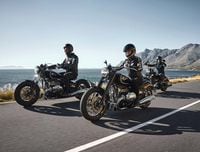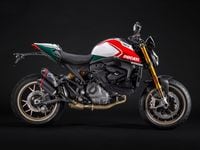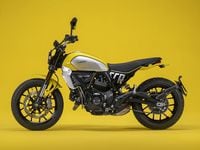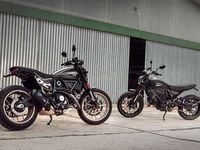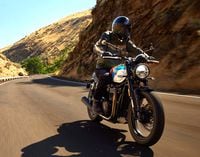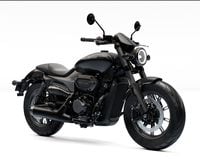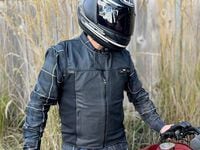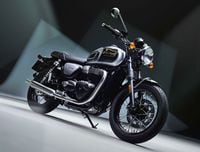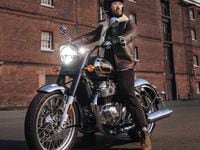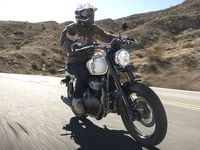We’ll admit it—inspiration for this list came to us after seeing Triumph’s new Rocket 3 TFC model release. Hearing numbers like 168 hp and 2,500cc prompted us to take a trip to the archives and revisit who exactly could stack up as legitimate competitors to the Rocket. Perennial power cruiser suspects like the VMAX, Vulcan, and VTX used to be a foregone conclusion, but the landscape has changed in the last couple of years. So is there any room left for those rubber-melting musclebikes of yore? We think there is, and some of the newer models carry on the big power tradition even more forcefully. As a bonus, some of these power mongers will even let you carve a canyon or two pretty handily (looking at you, Ducati). Let’s take a closer peek at some of our faves.
Mr. Max practically invented this category back in 1985, so we’ll list him first. It doesn’t hurt that the 65-degree, four-valve-per-cylinder, 1,679cc V-4 at the heart of the beast still produces eye-opening amounts of perfectly controllable acceleration, egged on by liquid-cooling, fuel injection, and a ride-by-wire throttle. Other supporting bits include a slipper clutch, dual wave-style brake discs with six-piston calipers, and suspension adjustability front and rear. A cruiser in sportbike clothing, or the other way around? Either way, this bike is no joke.
Triumph’s newest superlative supercruiser is the mammoth Rocket 3 TFC. With a claimed 168 hp and 163 pound-feet of torque emanating out of the 2,500cc triple, you’d better hang on for dear life when you twist the throttle. We haven’t seen a working production model just yet, but even if those numbers are off by 5 to 7 percent, we’re still talking ridiculous amounts of grunt. If it’s anything like its predecessor, that outrageous engine will be tempered by shockingly benign manners, much like the OG Rocket III was in 2004.
Related: Comparison: VMax vs. 3Max
The Bavarian bagger essentially gets sportbike-y bits shoehorned into a touring bike and somehow, with typical German precision, makes it all work oh-so-well. At its core is an inline-six tucked transversely in the frame and canted forward so it’s shorter as well as more compact. An oversquare 72mm bore and 67.5mm stroke pencils out to 1,649cc and a wicked 12.2:1 compression ratio. Hot stuff, especially since BMW claims a pretty lively 160 horses coming on at 7,750 rpm (along with 129 pound-feet of torque at 5,250 rpm).
Related: BMW K1600 B First Ride Review
Naked? Power cruiser? Sporty standard? Biggers brains than ours have debated the genre Ducati’s Diavel should slot into, so we’ll just give you the numbers. For 2019, Italy completely recast the Devilish One giving it a larger 1,262cc Testastretta DVT V-twin and a more streamlined but still hefty vibe. Ergonomics are a kind of hybrid between a relaxed standard and a racebike (which is what the factory calls a “power cruiser”), and despite that fat 240mm rear tire and the bike’s low-slung nature, the Diavel delivers good handling and a comfortable ride.
Redesigned from stem to stern in 2018, the new Gold Wing in standard trim (five versions are available) now resembles what used to be called the F6B: a stripped-down, lighter, and peppier bagger (with more than 40 degrees of available lean angle) rather than a fully loaded dresser. Which suits it fine; that 1,833cc flat-six mill is freed from hauling extra weight and can now fully exploit its 125 hp, along with the Honda-patented double-wishbone front end. The riding position is perfectly neutral, and that surprisingly deep available lean angle is just begging to be tested.
Related: 2014 Honda Valkyrie First Ride
Packing a 54-degree V-twin that displaces 109ci, or 1,783cc, the M109R is definitely a boss at this party. Although it’s virtually unchanged in more than a decade, the M109R still has plenty of street cred thanks to a modern design that brings a sport-oriented oversquare engine with a bore and stroke of 112.0 and 90.5mm. Using lightweight slipper-type pistons, four valves per cylinder, and dual-overhead camshafts, the excellent V-twin mill is definitely rev-happy. If you can handle the space cowboy styling, the B.O.S.S. just might be your jam.
Moto Guzzi’s California series don’t often make the cut for listings of power cruisers, which is weird because that 1,380cc engine is awesome. With its broad shoulders and beefy stance, the lighter-weight Audace model brings the right attitude to the street and the 90-degree V-twin brings a healthy maximum power claim of 96 hp, with maximum torque claimed to be 89.2 pound-feet. Even if it’s just shy of 100 hp, this definitely feels like power cruiser territory.
Available only on CVO bikes, Harley’s air-/oil-cooled 117-inch motor is the biggest, most powerful V-twin to ever come from the factory. We’ve heard power numbers claiming a peak of 105 bhp and 125 pound-feet of torque at 3,500 rpm. After dyno testing it, we recorded 93.7 hp, but with a few legal tweaks, it’s a safe bet that the 1,923cc monster could legitimately break the 100-hp mark without breathing too heavily.
Indian claims its 1,133cc DOHC V-twin Scout unit makes 100 hp and 72 pound-feet of torque at 6,000 rpm, but we reckon it’s capable of much more as the engine feels so understressed even when you’re at WOT. Officially we’ve recorded 84.62 hp at 8,260 rpm and 63.85 pound-feet of torque at 3,220 rpm on our dyno, which is not insignificant, especially because the Scout serves that up in a smooth, flat line. Since the Scout is relatively light (558 pounds wet), performance is gutsier than you’d expect from a classically styled bike. This thing just flat-out rips.
The horsepower wars were also a real thing in the not-so-distant past. Here’s a look at some two-wheel tire-shredding blasts from the past we still get misty over.
Although the biggest, baddest Vulcan is no longer being produced, it was top dog during the mid- aughts, boasting a burly 2,053cc engine set in a classic V-twin configuration. The V2K’s old-school mill churned out 141 pound-feet of stump-pulling torque at 3,000 rpm which, combined with around 90-plus hp at the rear wheel, felt like you were riding a freight train.
Ahead of its time on several levels and bringing race-bred DNA to the street, Harley’s 1,250cc 60-degree Revolution V-twin mill pumped out a pretty spectacular 125 hp and 85 pound-feet of torque in the Night Rod model. Not too shabby for a bike much smaller and lighter than Milwaukee’s Big Twin offerings at the time, and a surefire bet to beat your buddies at red light drag races.
Although not in the Honda cruiser lineup for several years now, the 1,832cc bruiser is still a beast to be reckoned with. Okay, so it’s the same engine as found in the base Gold Wing, but in Valkyrie form it’s got less weight to push—you’ll be propelled across the earth that much quicker. The 1,832cc engine can make 104 hp and 110 pound-feet of torque.
1,179cc | 104 hp
Cranking out 104 hp at 8,000 rpm from a fuel-injected 1,179cc V-twin powerplant, the late lamented Victory Octane was a true power cruiser, especially when you consider it had a relatively low wet weight of 548 pounds to push. That engine was derived directly from the Victory Project 156 Pikes Peak racer, and is pretty close to the same one that’s now in the Indian Scout.










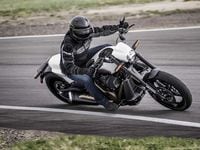
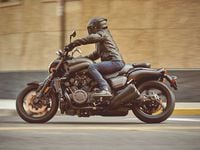
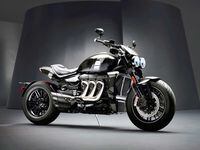
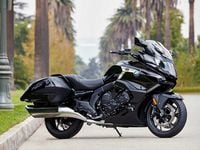
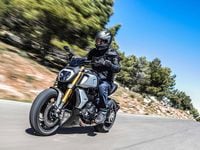
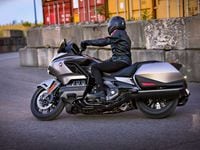
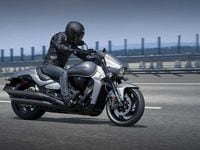
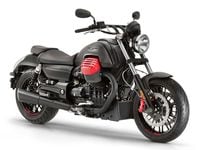
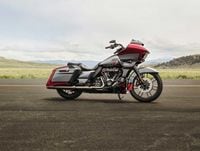
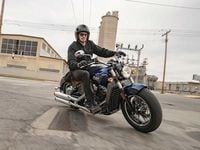
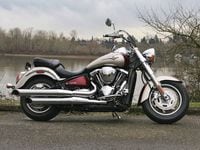
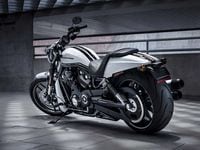
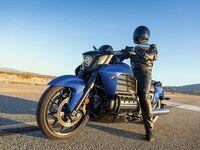
/cloudfront-us-east-1.images.arcpublishing.com/octane/H6Z2IC7WYRBXZNQS4MI3SZ5KPQ.jpg)
/cloudfront-us-east-1.images.arcpublishing.com/octane/IWO5T5PBT5E4HFQ5GK47H5YXR4.jpg)
/cloudfront-us-east-1.images.arcpublishing.com/octane/OQVCJOABCFC5NBEF2KIGRCV3XA.jpg)
/cloudfront-us-east-1.images.arcpublishing.com/octane/F3O2DGLA4ZBDJGNVV6T2IUTWK4.jpg)
/cloudfront-us-east-1.images.arcpublishing.com/octane/ZXYQE3MHLFDSPKNGWL7ER5WJ4U.jpg)
/cloudfront-us-east-1.images.arcpublishing.com/octane/RDF24VM7WVCOBPIR3V3R4KS63U.jpg)
/cloudfront-us-east-1.images.arcpublishing.com/octane/W7RSIBFISNHJLIJESSWTEBTZRQ.jpg)
/cloudfront-us-east-1.images.arcpublishing.com/octane/AERA26ENRNBW3K324YWCPEXYKM.jpg)
/cloudfront-us-east-1.images.arcpublishing.com/octane/YWX3YX7QBBHFXFDMEEEKRG4XJE.jpg)
/cloudfront-us-east-1.images.arcpublishing.com/octane/I7OKI53SZNDOBD2QPXV5VW4AR4.jpg)
/cloudfront-us-east-1.images.arcpublishing.com/octane/IH52EK3ZYZEDRD3HI3QAYOQOQY.jpg)
/cloudfront-us-east-1.images.arcpublishing.com/octane/K2FSAN7OWNAXRJBY32DMVINA44.jpg)
/cloudfront-us-east-1.images.arcpublishing.com/octane/G4XK7JL24FCUTKLZWUFVXOSOGE.jpg)
/cloudfront-us-east-1.images.arcpublishing.com/octane/JJNXVAC27ZCDDCMTHTQZTHO55Y.jpg)
